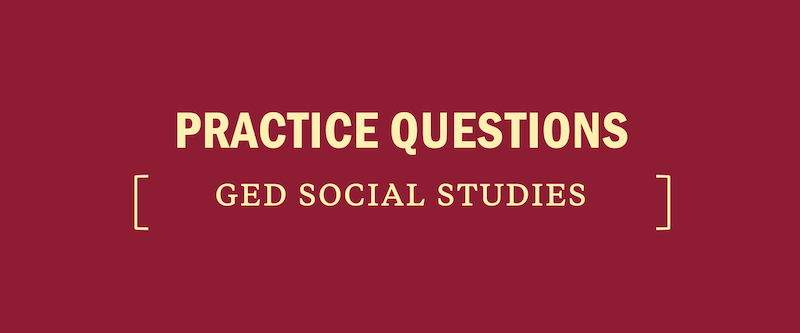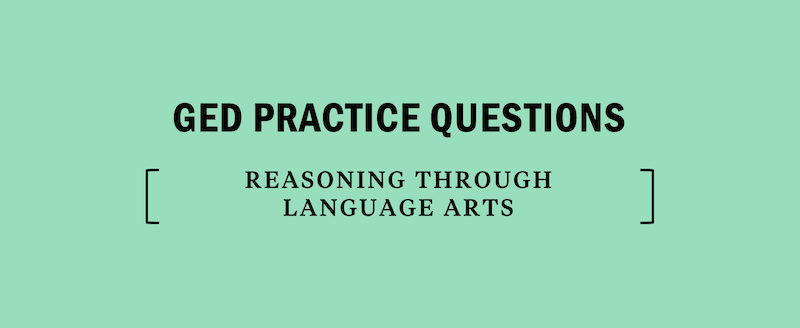Top Tips for the GED
If you’re studying for the GED, you know that there’s a lot of information to cover before you’re ready for test day. We’ve compiled a few tips for each section to help you out, whether you’ve just started studying or you’re taking the GED tomorrow.
Answer every question on the GED!
Remember to answer every question on the GED. There’s no penalty for wrong answers on the GED, so you should guess on questions you don’t know the answer to. If you’re worried about running out of time, answer the question quickly and flag it on the computer so you know to go back and check your answer later if you have extra time.
[ TRY KAPLAN’S GED PRACTICE QUESTIONS: Social Studies • Mathematical Reasoning • Science • Language Arts ]
GED Mathematical Reasoning Tips
Simplicity is best. There is often more than one way to work a problem, even when a function is given. Solve using the function. If you see another way to solve the problem, use it to check your answer. When it comes to combined figures, the rule is to solve it as easily as you can. The answer will be the same no matter how you break the figure down.
Keep your forms consistent. In applicable problems, skim the answer choices to see if they are in fraction, percent, or ratio form. Knowing the answer form will help you decide how to do your calculation. You should also make sure you reduce fractions to their lowest terms, since that’s how answer choices will be written.
Choose what to memorize. Having a formula sheet means that you’re not required to memorize any formulas for the Mathematical Reasoning test. That being said, you can save time by memorizing some of the more common formulas (i.e. area of a circle and rectangle, slope, surface area of prisms, etc.). You might also consider memorizing some prime numbers, and the squares of numbers 1 through 15 so you won’t be so reliant on your calculator.
Work backwards. You can work backward to check your answers. For example, if a price has decreased by 25%, the new price should be 75% of the original price, since 25% + 75% = 100%. This also works if you don’t know how to answer the question; if you are unsure about a multiple-choice algebra problem, substitute each of the answer choices for the variable in the equation. You may be able to do this quickly using your calculator.
GED Reasoning Through Language Arts Tips
Read the passage completely. Failing to read a passage completely in a passage-based question can lead you to jump to incorrect conclusions. As you read, check your understanding by pausing occasionally to see if you can restate and summarize what you are reading. You can also skim the questions before you read the passage–without intending to answer them yet– so you know what you’re looking for when you read. This is especially helpful when you’re answering questions related to two selections.
Read objectively. When you read two selections with opposing viewpoints, carefully analyze each writer’s arguments. Don’t let your opinions on the topic influence how you answer the questions. Focus on whether or not the writer adequately and validly supports the argument, not on whether or not you agree with them.
Know your commas. This might seem like an oddly specific tip, but knowing all the rules surrounding commas will help you a lot on the language skills portion of the Reasoning Through Language Arts Test. Here are a few specific comma tips:
- When you use a transition at the beginning of a sentence, be sure you put a comma after the transition.
- Read a sentence out loud to see if you hear a pause. Before you insert a comma, be sure that you can base your decision on a comma rule.
- When a modifying phrase is at the beginning of a sentence, use a comma to separate it from the rest of the sentence.
- When you revise a sentence to use parallel structure, use a comma to separate each element as shown in these examples.
- When you read a run-on sentence or a comma splice, look for the place where you would pause if you read the sentence aloud. That is the place where you would make the correction.
Read the prompt before you read the passages. On the Extended Response portion of the Reasoning Through Language Arts Test, you’ll be given two texts and a prompt. Read the prompt first. This will help you focus your reading to select key details and evidence that you can use to support your position.
Cite examples from the text. One key to a good score on the Extended Response is to cite specific evidence from the reading passage(s). This is called an “evidence-based” writing activity because you are expected to base your response on evidence from the texts. You can do this by using phrases such as “The passage stated…”; “In the text…”; and “One example from the text is…”
GED Social Studies Tips
Pay attention to the author’s viewpoint. You may be provided with a newspaper editorial, an online blog commentary, or a speech. Ask yourself, “What is the author’s viewpoint? How are facts and evidence organized to be convincing? How are words chosen to have an impact?” This will help you better understand the text and, ultimately, answer more questions correctly.
Don’t worry about names or dates. The world history questions require that you have familiarity with major topics in world history. You do not need to memorize names or dates. Instead, focus on understanding the causes and effects of historical events.
Read the newspaper. Some questions are based on important current topics such as the development and conservation of resources. Reading the newspaper or other periodicals will help you become familiar with many of these issues and how they relate to other historical events.
Don’t let charts or graphics throw you. When you interpret a graphic on the Social Studies test, carefully read the title and all labels and keys to make sure that you correctly understand the main idea and the type of information being displayed. When a text accompanies a graphic, read the questions carefully. Some questions may ask about the text or the graphic individually. Others may ask you to combine information from both sources.
GED Science Tips
Manage your time carefully. The Science Test doesn’t divide short-answer and multiple choice questions into separate sections, so it’s important that you’re aware of how much time you have. Manage your time with the Time Remaining clock in the toolbar at the top of the computer screen.
Cite examples from the text. Each Short-Answer response on the Science Test is worth up to 3 points. You can improve your score when you use two or three specific facts, details, or pieces of evidence from the passage in your response.
Don’t let charts and graphics throw you. Since many Science Test questions are based on diagrams and graphs, it is important to carefully read the titles and all of the other information on all graphics. Make sure you understand a graphic before answering questions based on it, and remember that you might be given more information than you need; weed out unnecessary information before you answer.
Know your physical science. Approximately 40% of the questions on the Science Test are about physical science topics, so now’s a good time to brush up!
Try to answer multiple choice questions before you read the answers. If one of the choices is similar to your answer, it’s probably correct!
[ KEEP STUDYING: What to expect on GED test day ]







